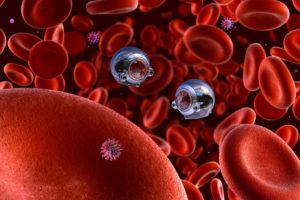Musk’s Neuralink Knew Brain Chip Was Likely To Malfunction In First Human Patient
Elon Musk’s Neuralink was aware that its brain implant was likely to malfunction in its first human patient, but went ahead with the surgery anyway, according to a new report.

In January, the firm implanted a brain chip in its first patient, Noland Arbaugh, who was paralyzed from the shoulders down due to a 2016 diving accident. Weeks after the procedure, some of the device’s wires pulled away from his brain, the company said recently.
Now, a report by Reuters claims that Neuralink had known about this issue “for years” following animal testing. Despite this, they deemed the risk low enough for a redesign not to be merited.
The Mail Online reports: Neuralink is testing its implant to give paralyzed patients the ability to use digital devices by thinking alone – a prospect that could help people with spinal cord injuries.
The company said that the implant’s tiny wires, which are thinner than a human hair, retracted from a patient’s brain in its first human trial, resulting in fewer electrodes that could measure brain signals.
The signals get translated into actions, such as moving a mouse cursor on a computer screen.
The company said it managed to restore the implant’s ability to monitor its patient’s brain signals by making changes that included modifying its algorithm to be more sensitive.
The sources declined to be identified, citing confidentiality agreements they had signed with the company. Neuralink and its executives did not respond to calls and emails seeking comment.
The US Food and Drug Administration was aware of the potential issue with the wires because the company shared the animal testing results as part of its application to begin human trials, one of the people said.
The FDA declined to comment on whether it was aware of the issue or its possible significance. The agency told Reuters it would continue to monitor the safety of patients enrolled in Neuralink’s study.
Were Neuralink to continue the trials without a redesign, it could face challenges should more wires pull out and its tweak to the algorithm proves insufficient, one of the sources said.
But redesigning the threads comes with its own risks.
Anchoring them in the brain, for example, could result in brain tissue damage if the threads dislodge or if the company needs to remove the device, two of the sources said.
The company has sought to design the threads in a way that makes their removal seamless, so that the implant can be updated over time as the technology improves, current and former employees say.
Neuralink’s post made no mention of adverse health effects to Arbaugh and did not disclose how many of the device’s 64 threads pulled out or stopped collecting brain data.
We are warned that nanorobots will flow through our bodies and connect our brains to the internet “by 2030”
Neuralink’s experiment is just one out of many that are going on these days, pursuing to transform people into man-machines.
Once you have thousands of nanorobots buzzing around inside your body, will you still have control over your consciousness, will, and emotions, or will the nanorobots be in charge? According to Google, a nanorobot is “a hypothetical, tiny, self-driving machine, specifically one that has some degree of autonomy and can reproduce.” Scientists in the United States have been working on nanorobots that can move through our bodies at astonishing speeds, deliver drugs to specific locations, and even penetrate our brain cells. Eventually, researchers hope to use nanorobots to connect our brains directly to the Internet.
Some experts even believe that nanorobots will one day actually be able to allow humans to live indefinitely.
Futurists often claim that nanorobots are the key to eternal life. Inventor, author and Google futurologist Ray Kurzweil claimed in an interview with Neil deGrasse that tiny nanorobots in our bloodstreams will save us from death in 2030. According to Kurzweil, the nanorobots will move inside us at the molecular level, protecting our biological system and ensuring that we live a good and long life. The future is closer than you might think! And this is the future they have planned for us.
In Colorado, a team of scientists has already developed nanorobots that can move through the human body “at amazing speed”.
Wyatt Shields, PhD, a chemical and biological engineer at the University of Colorado, says “Medical microrobots are essentially microscale devices. So they’re devices that are five to 10 times thinner than a human hair.”

A team of engineers at the University of Colorado, Boulder, has developed a new class of tiny, self-driving robots that can zip through a body at astonishing speeds. The robots are made from biocompatible polymer materials using technology similar to 3D printing. They look like small rockets with three tiny fins.
“And the result is that these robots move really fast. They move on the order of several hundred body lengths per second, I think 120 or 140 body lengths per second. That would be like a six-foot-tall human running 400 miles per hour”, adds Professor Shields.
Researchers envision a day when thousands of nanorobots will be buzzing around in our bodies, performing various tasks.
A company in California, for example, has been working on nanorobots designed to “transport drugs to exactly the place in the body where they are needed”.
California-based startup Bionaut Labs has developed a nanorobot the size of a grain of rice that is designed to deliver drugs to exactly the place in the body where they are needed. When you think about it, the traditional way of delivering drugs makes little sense: A painkiller works the whole body rather than just the arm that hurts, and chemotherapy is flushed through all the veins rather than precisely targeting the tumor. For many people, this technology will sound wonderful, as they do not see all its implications.
Several startups and academic institutes around the world are working on developing such a solution, but Bionaut Labs appears to be the furthest along in developing its invention. “You can imagine the Bionaut as a tiny screw that moves through the veins as if controlled by an invisible screwdriver until it reaches the tumor,” explains Shpigelmacher. Using Zoom, he shows the screen of an X-ray machine in his lab in Culver City to demonstrate how the semi-transparent, yellowish device winds its way inside the body along the spine. The nanorobot contains a tiny but powerful magnet. The “invisible screwdriver” is an external magnetic field that causes the magnet inside the device to rotate, causing it to move and change direction.
That may sound really impressive. But what are the dangers?
Many are concerned that nanorobot technology could one day be used to completely enslave humanity.
Already, scientists are developing nanobots that can enter the interior of cells and transmit information to the outside world.
Deblina Sarkar has big dreams for the little machines she makes. Some of her tiny electronic devices are smaller than a speck of dust. And her dreams? They’re so big, they might one day save your sanity.
Sarkar is an MIT scientist who is trying to use nanotechnology to help people with Alzheimer’s and Parkinson’s diseases.
Perhaps the most innovative device in her group is the Cell Rover. This rover is a tiny, flat antenna that can send a signal from inside a cell – without damaging it.
In a study last year, Sarkar and her colleagues inserted a Cell Rover into a frog egg cell. They used magnetic fields to gently slide the device into the egg. Once it was safely inside, the researchers activated another magnetic field. This caused the molecules in the nanodevice to vibrate.
These vibrations did not harm the cell. They only changed the magnetic field of the Cell Rover itself. A receiver outside the egg registered the changed magnetic field of the shaking rover. In this way, the device was able to communicate with the outside world.
But this is only the beginning of what the researchers hope to achieve.
Eventually, Sarkar hopes to insert nanodevices between human neurons. This could increase the computing speed of our brains. Our brains are remarkable, she says, but she adds, “We could be better than what we are.”
The researchers envision that they we will send medical nanorobots into our bloodstream. One application of these medical nanorobots will be to augment our immune systems. This is what it is called the third bridge to radical life extension. The first bridge is what we can do now, and the second bridge is perfecting biotechnology and reprogramming the software of life. The third bridge is these medical nanorobots to perfect the immune system. These robots will also penetrate the brain and enable virtual and augmented reality from within the nervous system rather than from devices attached to the outside of our bodies. The most important application of the medical nanorobots is that we will connect the top layers of our neocortex to the synthetic neocortex in the cloud.
What would our world look like if most of our brains were directly connected to the Internet through nanorobots?
The potential for tyranny would be obvious – A central authority that had power over these nanorobots could exert enormous influence over our thoughts, feelings and beliefs.
The scary aspect about nanorobots is that they are so small that they can enter the body unnoticed.
And once they’re running around inside you, it’s not easy to get them out.
yogaesoteric
May 29, 2024
